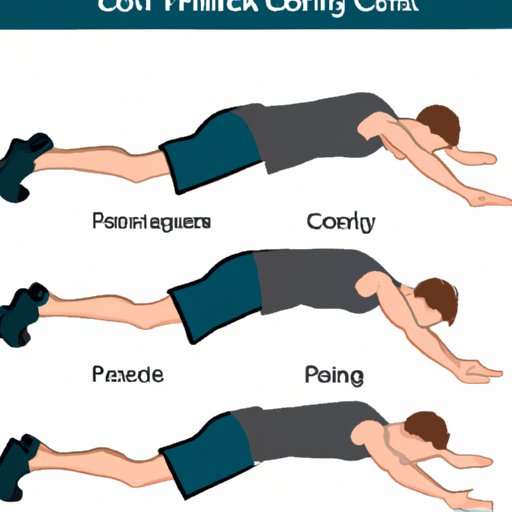
I. Introduction
If you’re looking for a simple, effective exercise to strengthen your core, look no further than the plank. This deceptively simple exercise engages your entire body, working not only your abs but your back, arms, and legs as well. Plus, you can do it practically anywhere, without any equipment. In this article, we’ll cover everything you need to know about how to do a plank, from proper technique to variations, benefits and common mistakes. Let’s dive in!
II. Step-by-Step Guide
The first step to doing a proper plank is getting into the right position. Start by getting into a push-up position with your palms and toes on the floor. Your arms should be straight, and your shoulders should be directly above your hands. Your body should form a straight line from your head to your heels.
Next, engage your core muscles by pulling your belly button towards your spine. Keep your hips level, and your glutes engaged. Try to imagine that you’re holding a coin between your butt cheeks. Hold this position for as long as you can, making sure to breathe deeply and evenly.
One of the most important aspects of performing a plank correctly is maintaining proper alignment. Make sure your head is in a neutral position, meaning your gaze should be towards the floor, with your neck in line with your spine. Also, try to avoid sagging in the middle or sticking your butt up in the air.
If you’re new to planking, start by holding the position for 10-30 seconds at a time. Gradually work your way up to holding the plank for a minute or longer. As you gain strength, you can try other variations, like side planks or knee planks.
III. Variations and Modifications
The great thing about planking is that there are countless ways to vary the exercise to keep things interesting and challenging. One modification is to try a side plank, which involves balancing on one forearm and the outside edge of one foot, while lifting your hips up towards the ceiling. Another variation is the knee plank, which involves resting your knees on the ground instead of keeping your legs straight.
You can also increase the difficulty of the plank by changing the position of your hands or feet. For example, raise one arm or leg off the ground or move them closer or wider from your shoulders. You can also add movements like mountain climbers or side-to-side hip dips while holding the plank position.
It’s important to know when to try advanced variations, though. Start with the basic plank first, and only move on to more advanced poses once you have built up enough strength and endurance.
IV. Benefits of Planking
Aside from building a stronger core, planking has a variety of other physical and mental health benefits. It helps to improve your posture, especially when done regularly, as it helps strengthen the muscles in your back and neck that support your spine.
In addition, it can help to relieve chronic back and neck pain by strengthening the muscles surrounding your spine and reducing the pressure on your joints.
Planking also helps to improve your flexibility and balance, which can reduce your risk of falls and other injuries. Finally, it’s a great way to reduce stress and improve focus, making it an excellent addition to your self-care routine.
V. Common Mistakes
While planking is a relatively low-impact exercise, it’s still essential to perform it with proper form to avoid injury and get the best results. One of the most common mistakes people make is letting their hips sag towards the ground. This not only takes the focus off your core but also puts excess strain on your lower back. Instead, focus on keeping your entire body in a straight line, with your hips lifted and your core engaged.
Another common mistake is holding your breath while performing the plank. This can cause your muscles to tense up and make it harder to maintain the position for a longer period. Instead, try to breathe deeply and evenly, focusing on exhaling fully in between breaths.
VI. Precautions and Considerations
If you have any pre-existing injuries or conditions that affect your back, neck, or shoulders, it’s always a good idea to consult with a doctor or physical therapist before starting any new exercise regimen. They can help you determine if planking is right for you and provide any modifications or precautions you should take.
It’s also important to make sure that you’re performing the plank with proper form. Avoid over-arching or rounding your spine, and make sure to keep your core engaged throughout the exercise to avoid unnecessary strain on your lower back. If you experience any pain or discomfort while performing the plank, stop immediately and consult with a professional.
VII. Conclusion
Now that you have a better understanding of how to do a plank, you can start reaping the numerous benefits this exercise has to offer. Just remember that like any other exercise, it’s best to start slowly and gradually increase your intensity over time.





